|
At the 2008 SHOT
Show in Las Vegas, Nevada, probably the most anticipated
new gun introduction was held at the Ruger booth on the
morning of the first day. About a week earlier, I had heard
rumor of what was to be introduced, but still joined a massive
crowd at the booth to see the new pocket pistol from Ruger. I
stood near the back of the crowd, but told Boge to get up
front and get some good pictures, which he did. Since that day
almost four weeks ago, we have been flooded with emails asking
us to please review the new Ruger LCP. Here it is.
The LCP, which stands for Lightweight Compact
Pistol, is a new type of auto pistol for Ruger. Sturm, Ruger,
and Company was founded upon their excellent .22 Auto
Pistol, and they have produced several other auto pistol designs
since, but the new LCP is Rugerís first true pocket auto.
Chambered for the .380 ACP cartridge, it is squarely aimed at
the concealed carry market. Having a lightweight glass-filled
nylon frame and a steel slide, the baby Ruger weighs in at just
9.42 ounces empty on my scale. The LCP is a very lightweight
little pocket pistol.
Right from the start, the LCP has been compared
to the Kel-Tec pocket guns, so we might as well address
that now. The Ruger LCP is very similar in size and weight to
the Kel-Tec P3-AT .380 auto
pistol. The physical dimensions are listed below:
| |
Kel-Tec P3AT |
Ruger LCP |
| Weight |
8.3 Oz |
9.42 Oz |
| Frame Width |
0.798" |
0.790" |
| Barrel Length |
2.745" |
2.796" |
| Slide Width |
0.748" |
0.741" |
| Overall Length |
5.14" |
5.172" |
| Overall Height |
3.576" |
3.612" |
| Cartridge Capacity |
6+1 |
6+1 |
The P3-AT and LCP are very similar pistols,
built for the same purpose, and both are priced about the same.
The Ruger has a manual slide hold-open, and the Kel-Tec does
not. Both come with one magazine and a zippered soft case. The
extractors are different. The recoil springs are different.
Other than that, they are pretty close to the same, with the
Ruger being just a bit beefier, resulting in the slightly
heavier weight.
The trigger pull on the test gun was very good
for a small pocket gun, just about ideal. The pull weight
measured a smooth five pounds, six ounces. Ruger specifies eight
pounds, but my sample measured lighter, and much better than
comparable pistols of the type. The pull length is just over
one-half inch, and measures 2.514 inches from the backstrap to
the center of the trigger blade. There is ample room on the grip
for two fingers, leaving the little finger off the grip
entirely. For those who prefer a finger hold for the little
finger, I expect that Pearce Grip will have one available
immediately to replace the standard magazine floorplate. The
little LCP is very controllable, and was fired for accuracy at
seven, fifteen, and twenty-five yards. I was pleasantly
surprised by the accuracy of Miss Elsie Pea. She performed
better than I expected, and no attempt was made to shoot from a
rested position, as this is not a target or hunting handgun. It
is a defensive fighting pistol, and was fired as such.
Twenty-five yards is stretching it for a .380 pocket gun, but
keeping all the shots from a full magazine in the kill zone of a
half-size human silhouette is easy to do, standing on my hind
legs and shooting like a man. At seven yards, keeping seven
rounds in the head zone of a half-size silhouette rapid fire was
equally easy, and slow fire standing offhand at fifteen yards
grouped five shots into two inches. For a pocket gun with tiny
sights, that is good accuracy. For any social situation in which
the Elsie Pea is likely to be used, that is all the accuracy
that anyone needs.
The magazine release on the LCP is easy to reach
with the thumb of a right-handed shooter, or the trigger finger
of a left-handed shooter. It pushes in easily, but not so easily
that I had any problems with the magazine popping out while in
my pocket. The Elsie Pea operates on a locked-breech system like
larger pistols instead on the blowback principle, and as a
result, the gun is lighter in weight and does not have an
excessively heavy recoil spring, as do many .380 auto pistols.
The LCP uses a dual-spring system on a steel guide rod. Take
down for cleaning and lubrication is easily done by dropping the
magazine, making sure that the chamber is empty, and sliding out
the disassembly pin. The magazine has a removable plastic
floorplate, and is also easy to take apart for cleaning. When
the magazine is emptied, the slide does not lock to the rear,
but the LCP does have a manual slide hold-open latch for
inspection and cleaning. All sharp edges have been eliminated on
the LCP, and it is as smooth as a used bar of soap, reducing
wear to both clothing and skin. Also, the trigger does not tend
to pinch my finger as sometimes happens with other small pocket
pistols.
Reliability was excellent with the little Ruger.
One failure to feed was traced to a dented cartridge case. How
it got dented, I do not know, but it came out of the box that
way. I tried every type of factory .380 ACP ammo that I had on
hand, along with a favorite handloaded hollowpoint load. The
variety included jacketed hollowpoint, round nose full metal
jacket, flat nose full metal jacket, polymer tip PowRBall,
hollow cavity homogenous copper hollow cavity, and cast lead
flat nose bullet ammunition. Everything fed, fired, and ejected
perfectly. I fired Elsie Pea one-handed, two-handed, held
upright, sideways, and upside down. The short barrel posted
respectable velocities, clocked over my PACT Professional
chronograph. Air temperatures were around the 50 degree mark
(Fahrenheit), at an elevation of approximately 400 feet above
sea level. Velocity reading were taken at ten feet from the
muzzle, and are listed in feet-per-second in the chart below.
FMJ is full metal jacket. JHP is jacketed hollowpoint. DPX is a Cor-Bon
load using Barnes XPB bullets. JFN is full metal jacket
flatnose. HC is a hard cast lead flatnose bullet. Glaser
Safety Slug is a pre-fragmented bullet. PowRBall is a
polymer-tipped ball inserted into a hollow cavity jacketed
bullet. Bullet weight is listed in grains.
| Ammunition |
Bullet Weight |
Velocity |
| Buffalo Bore HC |
100 |
1110.4 |
| Buffalo Bore JFN |
95 |
1012.5 |
| Buffalo Bore JHP |
90 |
1077.6 |
| Glaser Safety Slug |
70 |
1190.7 |
| Cor-Bon PowRBall |
70 |
1210.3 |
| Cor-Bon DPX |
80 |
1021.1 |
| Cor-Bon JHP |
90 |
948.8 |
| Remington JHP |
88 |
877.5 |
| Remington FMJ |
90 |
827.2 |
| Federal FMJ |
90 |
849.6 |
| Handload JHP |
88 |
879.9 |
Recoil with all loads tested was very
controllable, but of course snappier with the heavier, faster
loads. The laws of physics must be obeyed, and the Buffalo
Bore loads dealt out more recoil, but also deliver more
power on target than does standard ammunition, and that power is
worth the extra recoil. In any small-caliber handgun,
penetration is paramount, and the heavier bullets from those
Buffalo Bore loads penetrate flesh and bone better than lighter
bullets. However, I would carry the LCP with any of the first
six loads listed, as I think that all of those do a pretty good
job for such a small pocket gun. No concealable handgun carries
the power of a medium bore rifle, and in any handgun fight, I
would never count on one shot stopping any attacker. Keep
shooting until the punk knows he has been shot, and expires or
leaves the fight. This rule applies with even a .45 auto pistol,
and especially with any smaller cartridge. Elsie Pea holds six
rounds of .380 ACP ammo in her magazine, for a total loaded
capacity of seven. Much smaller and lighter than the lightest
.38 Special revolver but holding two more cartridges, she is a
dandy choice for a pocket pistol that can always be with you, no
matter where you are or what you are wearing. I can easily hide
this little pistol in my jeans pocket. Heck, it will even hide
in a shirt pocket. That is the beauty of little guns like this;
they are always with you. If I was to get caught in a fight, I
would prefer a shotgun, rifle, or for a handgun, a big .45 auto
pistol. However, I hardly ever carry one of those on a regular
basis. While you, thankfully, will never see me on the beach
wearing a Speedo, in hot weather, I seldom wear anything but
jeans and a tee shirt, and a big pistol is near impossible to
hide, but I always have a smaller handgun in my pocket. Always.
Little guns like this LCP can always be within reach. I stress
the word ďalwaysĒ because we never know when trouble will
come. We need a gun that can be reached in a fraction of a
second. When an attack takes place, the victim is found in the
unfair position of having to react to an attack in progress. The
attacker has time to plan the event, carefully select his
victim, and proceed with the crime. The victim is at a great
disadvantage, and is almost always taken by surprise. The gun
must be within reach. That nice high-dollar custom 1911 in the
glove box of the pickup will do you no good if you canít reach
it. It is the gun that you have with you that must help you to
win the fight. Elsie Pea can always be with you.
The Ruger LCP began shipping today (February
29th, 2008). Priced at this time at $330 retail, many dealers
are pre-selling the little guns for under $300. Ruger has orders
for several thousand of the little pistols already. If they all
prove to be as accurate and reliable as mine, they certainly
have a winner in the new LCP. Elsie Pea is a dandy little gun,
and I highly recommend her as an everyday, everywhere handgun,
and a great little pocket protector.
Check out the full line of Ruger products
here.
To find a Ruger dealer near you, click on the
DEALER FINDER at www.lipseys.com.
To order the LCP online, go to www.galleryofguns.com.
For more details on ordering any of the
ammunition listed above, go to www.buffalobore.com,
www.cor-bon.com, www.remington.com,
and www.federalcartridge.com.
Jeff Quinn
| For a list of dealers where you can
buy this gun, go to: |
|
To buy this gun online, go to: |
 |
|

|
|
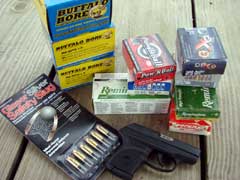
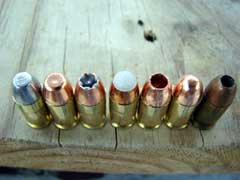
Author tested the LCP with a variety of
ammunition.

Seven-yard offhand rapid-fire group shows the LCP
would be a handy defensive companion.
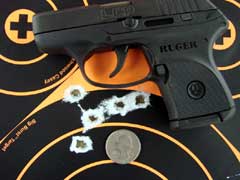
Fifteen-yard offhand slow-fire groups demonstrates
the accuracy of the LCP.
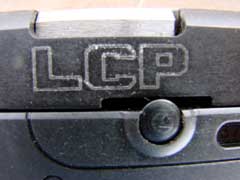
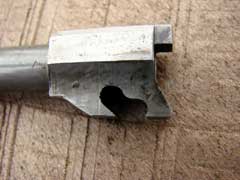
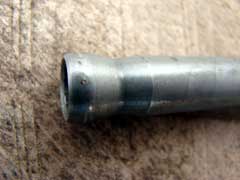

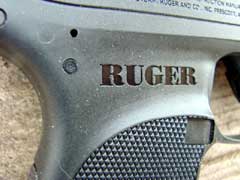
|
  
Got something to say about this article? Want to agree (or
disagree) with it? Click the following link to go to the GUNBlast Feedback Page.
|
Click pictures for a larger version.
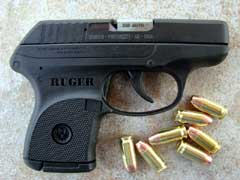
Ruger's new LCP (Lightweight Compact Pistol).
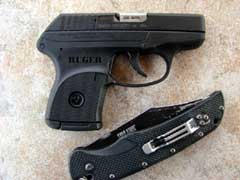
The LCP is lighter and not much bigger than Jeff's
pocket knife.
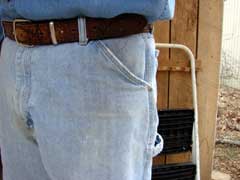
The LCP easily disappears into a jeans pocket.
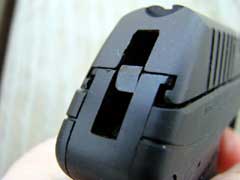
Hammer does not protrude from rear of slide or
frame.
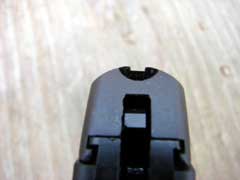
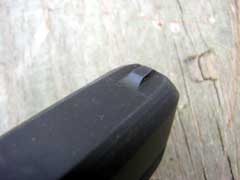
Sights are small, but useful and unobtrusive.
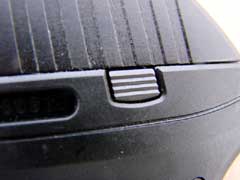
Manual slide hold-open latch.
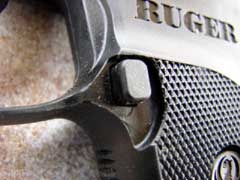
Magazine release is easy to operate.
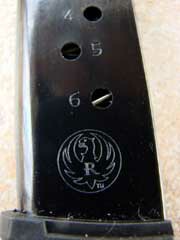
Six-shot steel magazine.
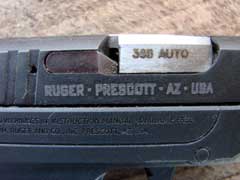

The included padlock is bigger and heavier than the
pistol!

The LCP also comes with a soft case.

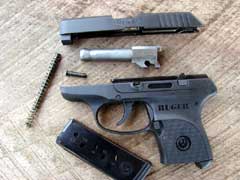
Disassembly is quick and easy.
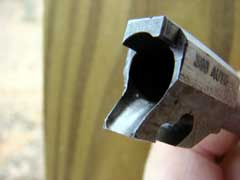
Feed ramp is nicely smoothed and polished, adding
to the reliability of the weapon.
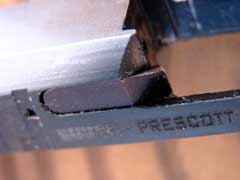
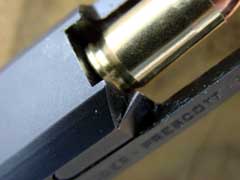
Reliability is further enhanced by a beefy extractor.
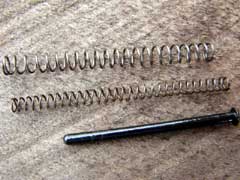
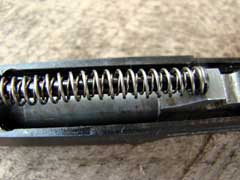
Steel guide rod is surrounded by dual recoil
springs.
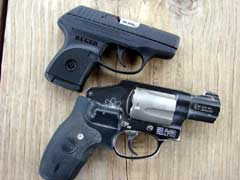
The LCP is tiny even when compared to a pocket revolver
like Jeff's Smith & Wesson 342PD.
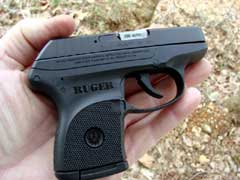

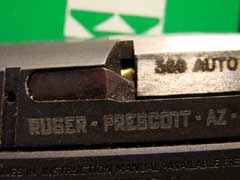
It's easy to visually check loaded condition.
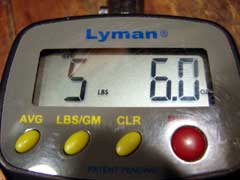
Lyman digital trigger pull gauge shows the LCP's
trigger pull is excellent, much lighter than maximum
specs.
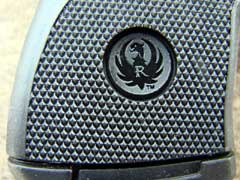
|
![]()